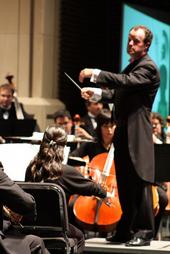Symphony orchestra facts for kids
A symphony orchestra is a large group of musicians who play many different instruments together. They perform classical music, movie scores, and sometimes even pop songs. It's like a big team where everyone plays their part to create beautiful sounds. A full symphony orchestra can have over 100 musicians!
Contents
What is a Symphony Orchestra?
A symphony is a long piece of music, usually for an orchestra. It is often divided into several parts called movements. These movements are like different chapters in a book. They usually have different speeds and moods. For example, one movement might be fast and exciting, while another is slow and peaceful. By the late 1700s, the idea of a symphony orchestra playing these multi-movement works became very popular.
Instruments in the Orchestra
A symphony orchestra has four main families of instruments. Each family makes a unique sound and plays an important role.
String Instruments
The string section is the largest part of the orchestra. These instruments make sound when musicians draw a bow across their strings or pluck them.
- Violins: The smallest and highest-pitched string instruments. There are usually two groups of violins: first violins and second violins.
- Violas: Slightly larger than violins, with a deeper, warmer sound.
- Cellos: Much larger, played while seated, with a rich, deep tone.
- Double Basses: The largest and lowest-pitched string instruments, providing the foundation of the sound.
- Harp: A beautiful instrument with many strings, often used for special effects.
Woodwind Instruments
Woodwind instruments create sound when air is blown through them. Many of them used to be made of wood, which is how they got their name.
- Flutes: Produce a bright, clear sound.
- Oboes: Have a distinct, reedy sound, often used to tune the orchestra.
- Clarinets: Can play a wide range of notes, from warm and mellow to bright.
- Bassoons: The largest woodwinds, with a deep, rich sound.
Brass Instruments
Brass instruments make sound when musicians buzz their lips into a mouthpiece. They are known for their powerful and majestic sound.
- Trumpets: Have a bright, piercing sound.
- French Horns: Produce a warm, mellow sound that can blend well with both woodwinds and strings.
- Trombones: Use a slide to change notes, creating a powerful sound.
- Tubas: The largest and lowest-pitched brass instruments, providing a deep foundation.
Percussion Instruments
Percussion instruments make sound when they are hit, shaken, or scraped. They add rhythm, color, and excitement to the music.
- Timpani: Large drums with pedals to change their pitch.
- Drums: Many types, like snare drums and bass drums.
- Cymbals: Used for crashing sounds.
- Xylophone: A melodic instrument with wooden bars.
- Other instruments like triangles, tambourines, and gongs are also used.
The Conductor's Role
The conductor is the leader of the orchestra. They stand in front of the musicians and guide them through the music. The conductor's job is very important because they:
- Keep time and set the speed of the music.
- Show musicians when to start and stop playing.
- Help the orchestra play together as one.
- Interpret the music, deciding how it should sound and feel.
Conductors often use a small stick called a baton to help them show the beat and direct the musicians. They also use their hands, arms, and even their facial expressions to communicate with the orchestra.
Where Do Orchestras Play?
Symphony orchestras usually perform in large concert halls. These halls are designed to make the music sound its best. The stage is often arranged so that all the musicians can see the conductor clearly. Orchestras also perform for ballets, operas, and even record music for movies and video games.
Images for kids
-
Apo Hsu, using a baton, conducts the NTNU Symphony Orchestra in Taipei, Republic of China
See also
 In Spanish: Orquesta sinfónica para niños
In Spanish: Orquesta sinfónica para niños






